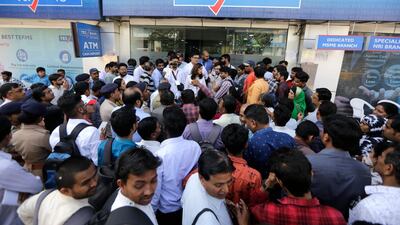India’s rupee weakened to its lowest since 2018 and stocks tumbled after the central bank seized control of beleaguered Yes Bank, intensifying the risk-off mood fuelled by the spread of coronavirus cases in India.
The S&P BSE Sensex slid 2.3 per cent at the close to 37,576.62 in Mumbai, paring an intraday loss of almost 4 per cent. The rupee fell as much as 1.1 per cent before trimming losses on what traders said was suspected central bank intervention.
“Investors have turned risk-averse and the contagion is likely to hit smaller bank and nonbank finance companies,” said Abhimanyu Sofat, Mumbai-based head of research at IIFL Securities. “How soon the RBI finalises the rescue plan is key as persistent operational curbs increase uncertainty.”
The Reserve Bank of India put strict limits on the lender’s operations while a rescue plan is devised. Under a government-backed proposal, State Bank of India, the nation’s largest lender, will lead a group that will inject new capital into Yes Bank, people familiar with the matter said on Thursday.
The curbs could hardly have come at a worse time, with Indian assets already reeling from the economic impact of the outbreak. Primary schools in New Delhi have been closed until March 31 to prevent the spread of the virus with the number of confirmed patients across the country jumping to 31 this week.
The RBI capped withdrawals from Yes Bank, the country's fourth-largest lender, at 50,000 rupees (Dh2,483) and ordered it not to issue new loans. The lender’s shares collapsed as much as 85 per cent before paring some losses after Governor Shaktikanta Das said the solution for Yes Bank would be swift. State Bank tumbled 6.5 per cent, while the yield on 10-year government debt slid 7 basis points.
The RBI's seizure of Yes Bank late Thursday was the country’s biggest such intervention in at least 13 years. Speculation of a government rescue had been swirling for months, but the announcement unnerved markets by leaving several key questions unanswered, including the fate of depositors, creditors and shareholders.
Also unclear was how Yes Bank clients and counterparties would cope with government-imposed caps on individual withdrawals and a 30-day moratorium on new loans and payments. A Walmart-backed Indian payments service that relies on Yes Bank to process transactions for more than 175 million users went down late Thursday, underscoring the far-reaching consequences of halting major portions of the bank’s operations.
Investors responded by dumping Yes Bank’s bonds and shares as well as those of other smaller lenders. Lines to withdraw money at one of Yes Bank’s branches in Mumbai were larger than usual around midday on Friday, with security officers telling customers they would have to wait one and a half hours to get cash after ATMs ran out of bills.
“The market was expecting a solution,” said Nilesh Shah, chief executive and managing director of Kotak Mahindra Asset Management. “People are bound to react the way they have this morning, but the panic can easily be controlled if the government announces the contours of the revival plan.”
The RBI took the decision to seize Yes Bank after noticing a surge in withdrawals by depositors, people with knowledge of the matter said. Policymakers were concerned that the outflows would accelerate once the bank releases its earnings on March 14, which could show a jump in bad loans, the people said, asking not to be identified as the matter was private. The decision came as a surprise to most Yes Bank executives.
The hashtag #YesBankCrisis was trending worldwide on Twitter. Many users shared their worries about possibly losing their deposits, even after Finance Minister Nirmala Sitharaman told reporters on Friday that the money was safe.
“I have about 150,000 rupees in savings here,” said Amit Shinde, a 28-year-old construction contractor, as he waited in line to take out cash. “I will be withdrawing it as soon as its possible. I don’t have confidence in the institution any more.”
Regulators’ failure to provide a detailed road map for Yes Bank’s rescue was criticised by some analysts and investors, who said the uncertainty could disrupt the smooth functioning of India’s financial system and crimp funding to non-state banks. Private lenders accounted for about 60 per cent of the nation’s new loan growth over the past 12 months, according to Credit Suisse Group.
More financial turbulence is the last thing India’s economy needs. While it expanded at the fastest pace among large countries worldwide about a year ago, it has since been battered by a shadow-banking crisis, waning consumer demand and the global coronavirus outbreak. Growth is projected by the government to slow to 5 per cent in the fiscal year ended March, an 11-year low.

